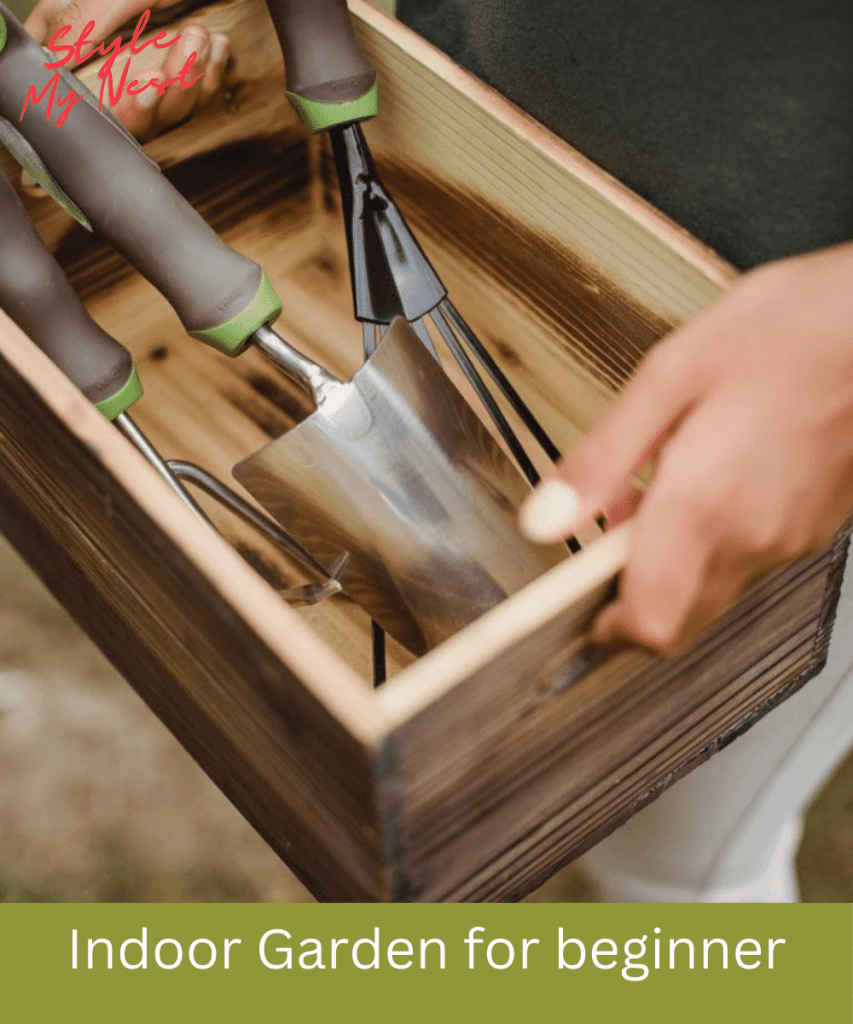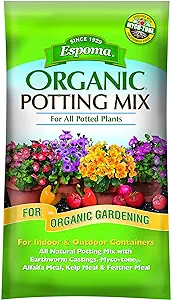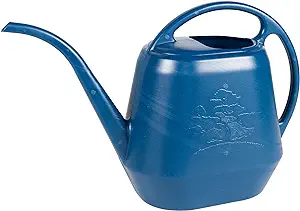Are you ready to transform your living space into a lush oasis? Discover the secrets of successful indoor gardening for beginners in our detailed guide: ‘Indoor Gardening for Beginner : A Details Guide to Easy Plants’!
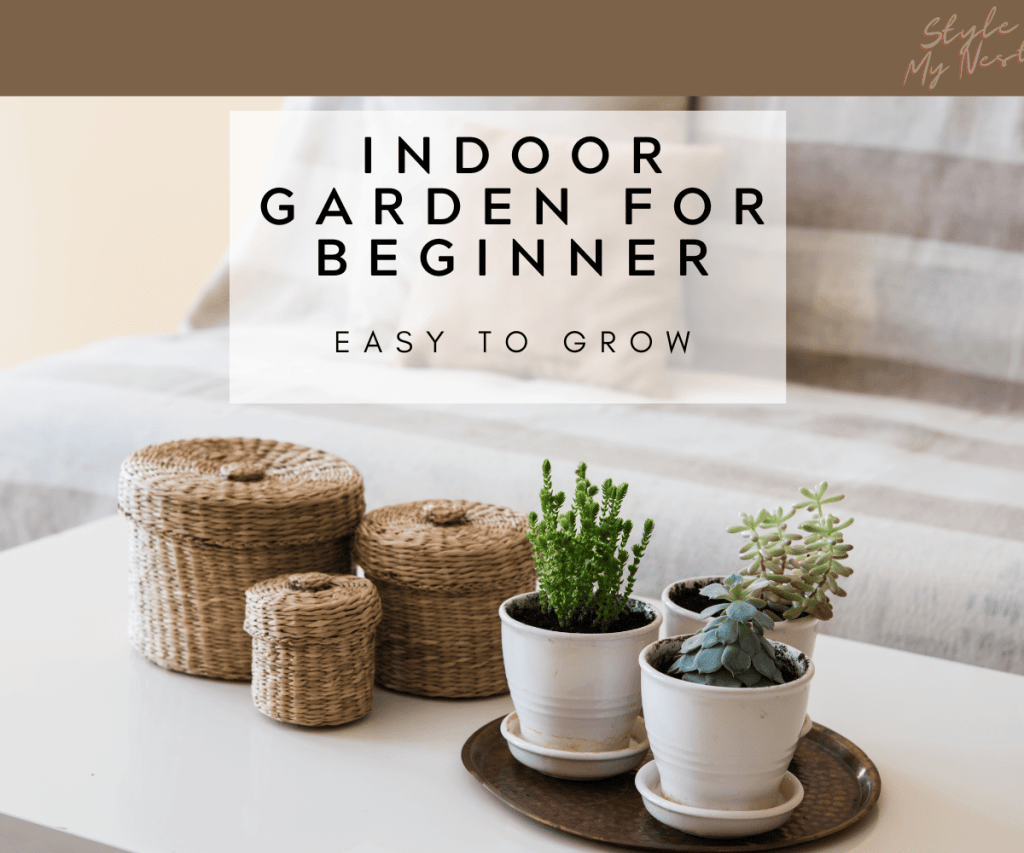
Step into the world of indoor gardening, where every leaf tells a story, and every bloom brings a smile. Transform your living space into a green sanctuary where nature’s magic unfolds in the heart of your home. Join us on this verdant journey and discover how to cultivate your very own oasis of tranquility.
Indoor gardening is more than a hobby; it’s a journey into the heart of nature without stepping outside your door. It’s about creating a personal sanctuary that reflects your style and nurtures your well-being.
From the soft rustle of leaves to the subtle fragrance of blooming flowers, each element adds to the symphony of your indoor garden. Whether living in a small apartment with limited space or a large house with ample room, there’s always a way to incorporate greenery into your living space.
I’ll share the secrets and joys of creating an indoor garden in this guide. Drawing from my experiences, I’ll take you through every step, from planning and plant selection to maintenance and care.
Understanding Indoor Gardens
Indoor gardening is more than just placing potted plants around the house. It’s about creating an ecosystem that brings a slice of the outdoors inside. The benefits are manifold, from purifying air to enhancing mental well-being. In my own home, I’ve felt the calming influence of greenery, offering a respite from the urban hustle.
Indoor Gardening for Beginner
When planning your indoor garden, consider the space available and the environmental conditions of your home. I started with a corner by the window, but soon, every nook became a potential spot for a new plant. Here are some factors to consider:
Space: Assess the space available. Are you looking at a small windowsill, a spacious living room, or a cozy balcony? Measure the area to understand how many and what size of plants it can accommodate.
Light: Identify the direction your windows face and the amount of natural light they receive. North-facing windows get less light, ideal for shade-tolerant plants, while south-facing windows are great for sun-loving varieties.
Humidity and Temperature: Most indoor plants prefer temperatures between 65-75°F (18-24°C) and moderate humidity. I use a digital hygrometer to monitor these conditions. Consider using a humidifier, especially when your home is dry, especially in winter.
Aesthetic: Think about the look you’re going for. Do you want a minimalist approach with large statement plants or a more eclectic look with various smaller plants?
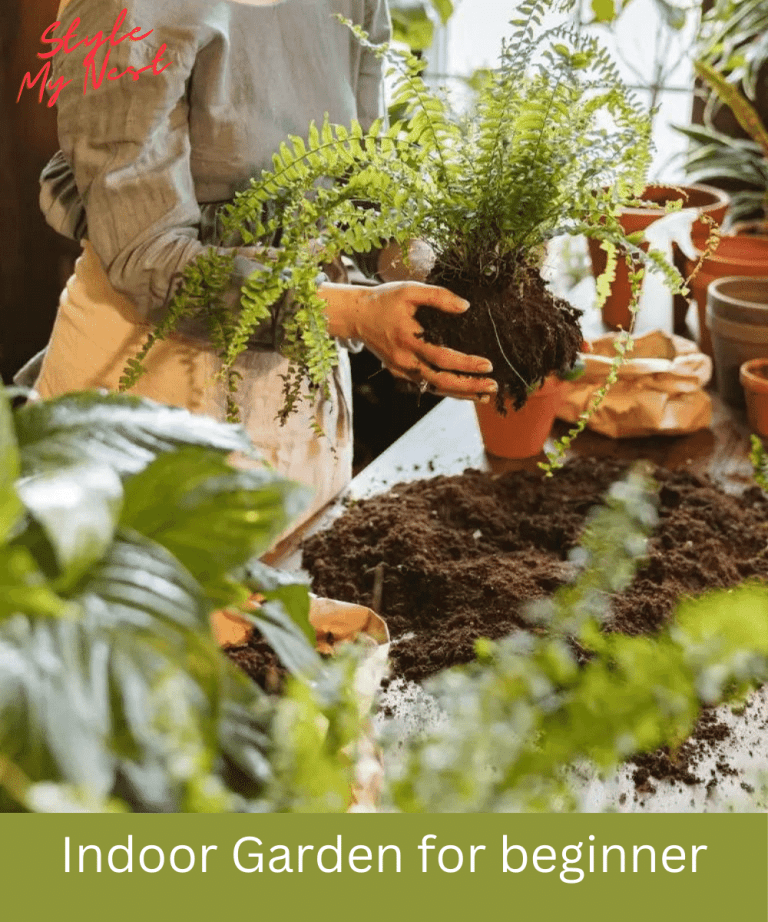
Selecting Plants for Your Indoor Garden
Choosing the right plants is critical to a successful indoor garden for beginner. Here are some recommendations, each suited to different conditions and levels of gardening expertise:
For Low Light Environments:
Pothos:
The Indestructible Wonder If you’re notorious for neglecting your plants, the pothos is your perfect match. This resilient plant can adapt to various lighting conditions and requires minimal watering. With its effortless propagation, you can effortlessly expand your green oasis.
Snake Plant:
Hardy and Air Purifying Meet the superhero of low light environments – the snake plant. Not only does it survive with infrequent watering, but it also purifies the air, making it an ideal companion for any room. Its durability and elegance make it a must-have for every plant lover.
Peace Lily (Spathiphyllum):
Known for its air-purifying qualities, it thrives in shade and adds elegance with its white blooms.
ZZ Plant:
The Epitome of Foolproof Looking for something unique yet undemanding? Enter the ZZ plant. With its glossy leaves and minimal care requirements, it adds a touch of sophistication to any space. Embrace its resilience and let it thrive in your home with ease.
For Brighter Light Environment:
Spider Plant (Chlorophytum comosum):
Easy to grow, it thrives in bright, indirect light and is known for its air-purifying abilities.
Rubber Plant (Ficus elastica):
Its glossy leaves are a striking addition, and it prefers bright, indirect light.
For Direct Sunlight Environment:
Aloe Vera:
Known for its medicinal properties, it loves direct sunlight and requires little water.
Jade Plant (Crassula ovata):
A succulent that thrives in direct sun and needs minimal watering.
Designing Your Indoor Garden
Designing your indoor garden is where creativity meets botany. It’s an exciting process that allows you to infuse your style into your living space while considering the needs of your plants. Through my own experiences, I’ve learned that a well-designed indoor garden can transform the ambiance of a home, creating a serene and inviting atmosphere. Here’s how to approach this creative process:
Define Your Style: First, decide on the style of your indoor garden. Do you prefer a minimalist look with sleek, geometric planters and a monochrome palette? Or are you drawn to a bohemian aesthetic with various colorful, textured pots and diverse plant species? Your style choice will guide every other decision you make.
Choose a Focal Point: Every garden needs a centerpiece. It could be a large, statement plant like a Fiddle Leaf Fig or a unique arrangement of smaller plants. In my living room, a tall Monstera Deliciosa is an excellent focal point, drawing the eye with its dramatic leaves.
Play with Heights and Layers: Utilize plant stands, shelves, and hanging planters to create visual interest. Varying the heights and layers of plants adds depth and dimension to your space. I love using tiered plant stands to display my collection of succulents and small potted herbs.
Consider Plant Needs: While aesthetics are important, the health of your plants is paramount. Ensure each plant is perfectly placed in a location that meets light, humidity, and temperature requirements. For instance, I place my humidity-loving ferns in the bathroom, where they thrive in a moist environment.
Incorporate Decorative Elements: Beyond plants, consider adding decorative elements like stylish watering cans, unique planters, or even art pieces that complement your garden theme. These touches add personality and cohesiveness to your indoor garden.
Use Color Wisely: Colors can influence the mood of your space. Excellent greens, whites, and blues are calming, while warm reds, yellows, and oranges bring energy. In my study, combining green plants and blue pots creates a tranquil environment ideal for concentration.
Experiment and Evolve: Your indoor garden doesn’t have to be static. Feel free to experiment with different arrangements, add new plants, or swap out decorative elements. Gardening is dynamic, and your indoor garden can evolve with your tastes and seasons.
Remember that your indoor garden is an extension of your style and the natural world. It’s a living, breathing space that enhances your home’s aesthetic and contributes to your well-being. The joy of seeing your indoor garden flourish and transform over time is truly unmatched.
Essential Tools and Supplies
Having the right tools and supplies is crucial for the success of your indoor garden. These essentials ensure that your plants survive and thrive in their indoor environment.
Quality Potting Soil: The foundation of healthy plants is good soil. Opt for a high-quality potting mix that provides adequate drainage and nutrient retention. Each plant species may require a slightly different soil type, so do some research. For instance, orchids thrive in a bark-based mix, while cacti prefer a sandier soil.
Watering Tools: Over-watering is a common mistake in indoor gardening. Use a watering can with a long spout for precise watering, ensuring you don’t overwater or disturb the soil. A misting spray bottle is an excellent tool for plants that prefer humidity, like ferns.
Pruning Shears: Sharp, clean pruning shears are essential for trimming dead or overgrown foliage, keeping plants neat, and promoting healthy growth.
Fertilizers: Indoor plants require regular feeding to replenish nutrients depleted from the soil. Use a balanced, water-soluble fertilizer, and follow the recommended feeding schedule for each plant type.
Plant Containers with Drainage: Proper drainage is crucial in preventing root rot. Choose pots with drainage holes and place a saucer underneath to catch excess water.
Top Products For Indoor Gardening for Beginner
Espoma Organic Potting Soil Mix:
A good quality potting mix is foundational for indoor gardening. The Espoma Organic Potting Soil Mix is an excellent choice. It’s a rich blend of peat moss, humus, and perlite, perfect for various indoor plants. Myco-tone, a proprietary blend of mycorrhizae, enhances this mix, which promotes root growth, water retention, and nutrient uptake.
Bloem Aqua Rite Watering Can:
Effective watering is critical to plant health. The Bloem Aqua Rite Watering Can offers a sleek design with a long spout, perfect for reaching the soil of indoor plants without spilling water on the leaves or floor. It has a 56-ounce capacity, suitable for small to medium-sized indoor gardens, and its ergonomic handle makes it comfortable.
Fiskars Steel Pruning Shears:
Regular pruning is necessary to keep your indoor garden looking its best. The Fiskars Steel Pruning Shears are a reliable tool for this task. These shears are durable, with precision-ground steel blades that stay sharp longer and cut cleanly through plant material. The non-slip grip handle and easy-open lock make them safe and comfortable, even for extended gardening sessions.
Each of these products has been highly rated by users for their quality, effectiveness, and durability, making them excellent choices for novice and experienced indoor gardeners. Investing in the right tools can make your gardening experience more enjoyable and rewarding.
Maintenance and Care
Regular maintenance is the backbone of a thriving indoor garden. It involves more than just watering; it’s about being attentive to the needs of your plants.
Watering Routine: Establish a consistent watering schedule. Check the soil moisture levels regularly – the top inch of soil should be dry before you water again.
Pest Control: Look for signs of pests like discolored leaves or sticky residue. Natural pest control methods, such as neem oil or insecticidal soap, can be effective treatments.
Pruning and Deadheading: Regularly prune dead or yellowing leaves to encourage new growth. For flowering plants, deadheading spent blooms can promote further flowering.
Cleaning Leaves: Dust can accumulate on leaves, blocking sunlight and reducing photosynthesis. Gently wipe leaves with a damp cloth to keep them clean and healthy.
Advanced Techniques and Tips
As your confidence grows, you can explore more advanced indoor gardening techniques. These can bring new challenges and rewards.
Hydroponics: This soil-less gardening method uses a water-based, nutrient-rich solution to grow plants. It’s efficient and can yield impressive results, especially for herbs and leafy greens.
LED Grow Lights: If your space lacks natural light, LED grow lights can be a game-changer. They provide the light spectrum for photosynthesis and can significantly boost plant growth.
Propagating Plants: Learn to propagate your plants. This can be done through cuttings, division, or layering. It’s a cost-effective way to expand your garden.
Advanced Potting Techniques: Experiment with different potting techniques like terrariums or kokedama (moss balls). These can add unique elements to your indoor garden.
Embracing the Green Journey
Creating and nurturing an indoor garden is more than a hobby; it’s a journey that enriches your life and transforms your living space. It fosters a deeper connection with nature and provides a sense of accomplishment as you watch your plants grow and flourish. Remember, every gardener has their share of successes and challenges. Be patient, keep learning, and most importantly, enjoy the process. Your indoor garden reflects your care and dedication, a living testament to the joys of gardening.
FAQ Section for Indoor Gardening for Beginner
Indoor gardening can raise many questions, especially for those new to the hobby. Here’s an expanded FAQ section to help guide you through common queries:
Q: What are the best plants for low-light areas? A: Besides ZZ plants and Peace Lilies, consider adding Philodendrons and Cast Iron Plants to your low-light areas. These plants are tolerant of low light conditions, very forgiving, and easy to care for.
Q: How often should I water my indoor plants? A: The watering frequency depends on each plant’s specific needs, the season, and the humidity levels in your home. A general rule is to check the top inch of the soil; if it’s dry, it’s time to water. However, succulents and cacti require less frequent watering compared to tropical plants.
Q: Can I use outdoor soil for indoor plants? A: Using outdoor soil for indoor plants is not recommended as it can contain pests and pathogens and may not provide the proper drainage and nutrient balance. Indoor plants thrive best in potting mixes designed for their specific needs.
Q: How do I deal with pests in indoor gardens? A: Besides neem oil and insecticidal soap, you can also use mild dish soap and water to treat infested plants. Regularly inspecting your plants and maintaining a clean environment can help prevent pest infestations.
Q: How can I increase humidity for my indoor plants? A: You can increase humidity by misting your plants, using a humidifier, or placing a water tray near your plants. Grouping plants can also create a microclimate with higher humidity.
Q: What are some easy-to-care-for indoor plants for beginners? A: Snake plants, Spider plants, and Pothos are excellent choices for beginners. These plants are resilient and adapt well to indoor environments with varying conditions.
Q: How can I ensure my plants are getting enough light? A: Observe your plants for signs of too little light, like leggy stems or pale leaves. Rotate your plants regularly to ensure even light distribution. If natural light is insufficient, consider using grow lights.
Q: Is it necessary to repot indoor plants? How often should I do it? A: Repotting is necessary when plants outgrow their current pots or the soil becomes depleted. Most indoor plants need repotting every 1-2 years, but this can vary depending on the growth rate and size of the plant.
Q: Can I grow herbs indoors? A: Yes, many herbs thrive indoors, especially in sunny locations. Basil, mint, and chives are great options for an indoor herb garden.
Q: How can I make my indoor garden more sustainable? A: Use eco-friendly pots, recycle water when possible, and choose organic fertilizers. Propagating your plants is also a sustainable way to expand your garden without buying new plants.
